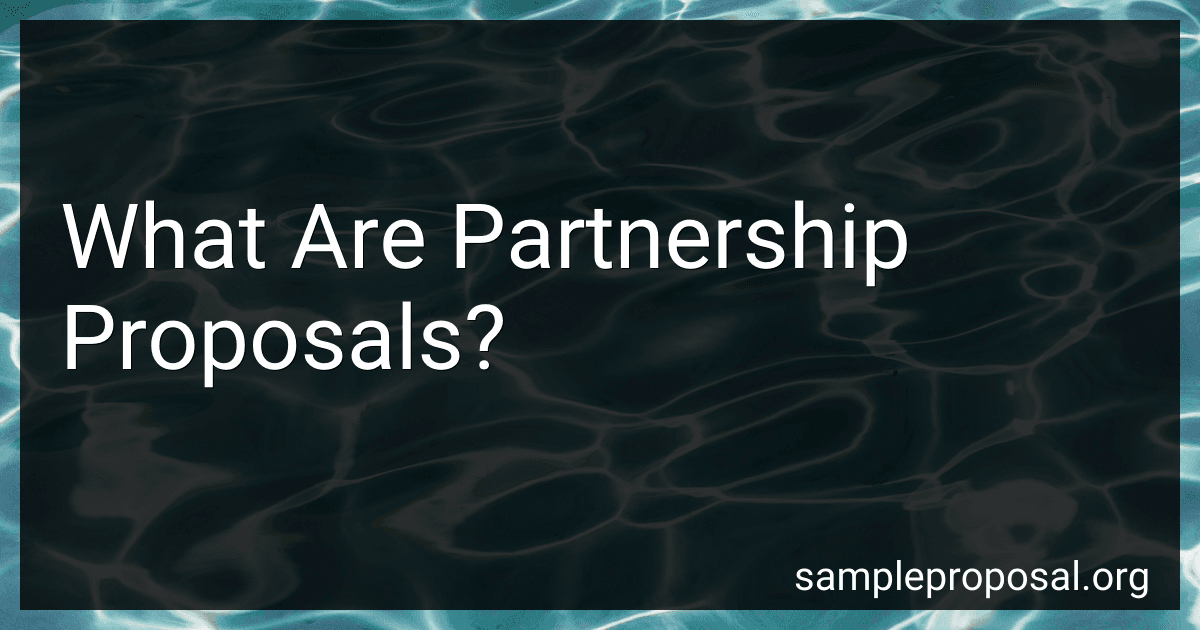Best Partnership Proposal Resources to Buy in December 2025

Grant Writing: A Practical Guide to Securing Funding for Your Organization, Tips and Techniques for Crafting Winning Proposals, and Building Lasting Partnerships With Funders



The Startup Equation: A Visual Guidebook to Building Your Startup


Partnership proposals are formal documents or presentations that are used to pitch a partnership or collaboration between two or more parties. These proposals outline the objectives, benefits, terms, and conditions of the potential partnership, as well as the commitments required from each party. Partnership proposals can be used to initiate new business ventures, joint projects, sponsorship arrangements, or any other type of partnership that requires mutual agreements and cooperation. The goal of a partnership proposal is to persuade the other party to enter into a partnership agreement by highlighting the value and advantages of the proposed partnership.
What is the process for negotiating terms in a partnership proposal?
Negotiating terms in a partnership proposal involves several key steps, including:
- Clearly define the goals and objectives of the partnership: Before beginning negotiations, both parties should clearly outline their goals and objectives for the partnership. This will help ensure that both parties are on the same page and working towards a mutually beneficial agreement.
- Identify key terms and conditions: Both parties should identify and agree upon the key terms and conditions of the partnership, such as the scope of work, responsibilities of each party, financial terms, duration of the partnership, and any exclusivity clauses.
- Discuss and negotiate terms: Once the key terms and conditions have been identified, both parties should engage in open and honest discussions to negotiate the terms of the partnership. This may involve compromising on certain terms, revisiting certain aspects of the agreement, or seeking additional clarification.
- Consider legal and regulatory requirements: It is important to consider any legal or regulatory requirements that may impact the partnership agreement. Both parties should ensure that the terms of the partnership comply with all relevant laws and regulations.
- Finalize the agreement: Once the terms of the partnership have been negotiated and agreed upon, both parties should work together to finalize the agreement. This may involve drafting a formal partnership agreement or contract that outlines the terms of the partnership in detail.
- Seek legal advice: It is advisable to seek legal advice before finalizing the partnership agreement to ensure that all terms are legally sound and provide adequate protection for both parties.
- Sign the agreement: Once the partnership agreement has been finalized and reviewed by legal counsel, both parties should sign the agreement to formalize their partnership.
By following these steps, both parties can successfully negotiate the terms of a partnership proposal and create a mutually beneficial agreement.
How to research a potential partner before submitting a proposal?
- Start by conducting a thorough online search of the potential partner's company. Look for information such as their mission, values, past projects, and key personnel.
- Check out the potential partner's social media profiles to get a sense of their company culture and communication style. Look for any recent news or updates that may impact your proposal.
- Look for any reviews or testimonials from previous clients or partners. This can give you insight into the potential partner's reputation and track record.
- Consider reaching out to contacts in your network who may have worked with the potential partner before. They may be able to provide valuable insights or recommendations.
- If possible, schedule a meeting or phone call with the potential partner to discuss your proposal and learn more about their needs and expectations. This will also give you an opportunity to gauge their communication style and how well you may work together.
- Consider conducting a background check on the potential partner to ensure they are financially stable and have a good standing in the industry.
- Finally, trust your instincts and gut feeling. If something doesn't feel right or if you have any doubts, it may be best to reconsider submitting a proposal to that potential partner.
How to address potential objections in a partnership proposal?
- Acknowledge the objection: Start by acknowledging the potential objection raised by the partner. This shows that you are actively listening and considering their concerns.
- Provide additional information: Offer more details, facts, or data to address the objection. This can help to clarify any misconceptions and provide a more comprehensive understanding of the proposal.
- Address the potential benefits: Highlight the potential benefits and advantages of the partnership proposal. Emphasize how the partnership can help achieve mutual goals and create value for both parties.
- Offer solutions or alternatives: If there are specific concerns or challenges raised, propose potential solutions or alternatives to address them. This demonstrates flexibility and willingness to work together to overcome obstacles.
- Be open to feedback: Encourage open communication and feedback from the partner. Show that you are open to addressing any further concerns or questions they may have.
- Provide examples or case studies: Share relevant examples or case studies of successful partnerships or similar initiatives to showcase the potential for a successful collaboration.
- Reiterate the value proposition: Restate the key value propositions of the partnership proposal and how it can positively impact both parties. Reinforce the idea that the partnership is a win-win opportunity.
- Follow up: After addressing the objections, follow up with the partner to ensure that their concerns have been adequately addressed and to continue the conversation towards finalizing the partnership agreement.
What are common mistakes to avoid in a partnership proposal?
- Lack of research: Failing to thoroughly research the potential partner and understand their business goals and values can lead to a mismatch in expectations.
- Lack of clear goals and objectives: A partnership proposal should clearly outline the goals and objectives of the partnership and how each partner will benefit. Failing to do so can result in confusion and disagreement down the line.
- Unrealistic expectations: Setting unrealistic expectations or promises in the proposal can damage trust and credibility with the potential partner.
- Lack of communication: Communication is key in any successful partnership. Failing to clearly communicate expectations, timelines, and responsibilities can lead to misunderstandings and conflict.
- Ignoring legal considerations: It's important to outline the legal aspects of the partnership, including roles and responsibilities, intellectual property rights, and dispute resolution procedures. Ignoring these considerations can lead to legal issues in the future.
- Focusing solely on your own interests: A partnership proposal should be a mutually beneficial agreement. Focusing solely on your own interests and not considering the interests of the potential partner can lead to resentment and a breakdown in the partnership.
- Not addressing potential risks: Every partnership comes with risks. Failing to address potential risks or have a plan in place to mitigate them can lead to problems down the line.
- Lack of follow-up: Simply sending a proposal and waiting for a response is not enough. Regular follow-up and communication are essential to demonstrate your commitment to the partnership.
How to address ROI in a partnership proposal?
One way to address ROI in a partnership proposal is to clearly outline the potential financial benefits of the partnership for both parties. This can include specific metrics such as increased revenue, cost savings, and efficiency improvements.
You can also provide case studies or examples of successful partnerships that have resulted in a positive ROI for all parties involved. This can help to demonstrate the potential success of the partnership and build credibility with the potential partner.
Additionally, you can discuss how the partnership will help to achieve mutual goals and objectives, and how these achievements will contribute to a positive ROI for both parties. It's important to highlight the value that each party brings to the partnership and how this will result in a win-win outcome.
Overall, addressing ROI in a partnership proposal involves clearly presenting the potential financial benefits of the partnership and demonstrating how the partnership will help to achieve mutual goals and objectives. This can help to position the partnership as a valuable investment for both parties.
How to incorporate data and statistics into a partnership proposal?
- Start by outlining the goals and objectives of the partnership proposal, highlighting the need for data and statistics to measure success and track progress.
- Provide relevant data and statistics that demonstrate the current state of the industry or market, as well as potential opportunities for growth or improvement. This could include market trends, consumer behavior insights, competitive analysis, or any other relevant data points.
- Use data and statistics to support your case for why the potential partner should consider collaborating with your organization. Show how a partnership could address specific challenges or capitalize on emerging opportunities based on the data.
- Incorporate data-driven metrics and key performance indicators (KPIs) that could be used to evaluate the success of the partnership. This could include revenue projections, customer acquisition goals, or any other measurable outcomes that align with the partnership objectives.
- Present the data and statistics in a clear and visually engaging format, such as charts, graphs, or infographics, to help illustrate your points and make the information easily digestible for the potential partner.
- Highlight any previous successful partnerships or collaborations where data and statistics played a key role in driving positive outcomes. This can serve as a concrete example of how data-driven decision-making can lead to successful partnerships.
- Lastly, emphasize the importance of ongoing data collection and analysis throughout the partnership to ensure continuous improvement and optimization. Clearly outline how data will be shared, analyzed, and utilized to drive strategic decision-making and achieve mutually beneficial outcomes for both parties involved.
